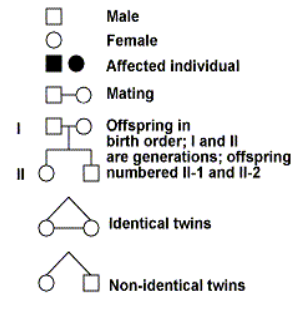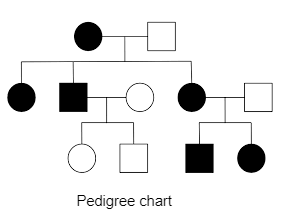Pedigrees are utilised for various animals, including humans, dogs, and horses. They are frequently used to investigate the transmission of genetic diseases. The goal of a pedigree is to create an easy-to-read chart that displays a specific trait or disorder in a person. It can be used to describe a physical trait such as a widow’s peak or connected earlobes and genetic illnesses such as colour blindness or Huntington’s disease. Pedigrees are significant in animals that are selectively bred for specific features and represent familial characteristics in people. They serve as visual representations of an animal’s forebears, making it easier to determine if that species will pass on certain traits to its young.
A pedigree is a diagram that illustrates an organism’s biological ties between its forefathers and mothers. Since the branches and lines of a pedigree resemble a thin crane’s leg with its branching toes, it is derived from the French “pied de grue” (crane’s foot)
Experts use a common set of symbols to make pedigrees easier to interpret. Males are symbolised by squares, whereas circles represent females. Horizontal lines connect the parents, and vertical lines originating from horizontal lines lead to the symbols for their children. Generations are denoted by numerals, with I being the first generation, II denoting the first generation’s children, and III denoting the first generation’s grandchildren.
Pedigree chart symbols


Analysis
- Each person is represented by a Roman numeral that stands for the family’s generation. A digit symbolises the individual within the generation. For example, individual I-1 is the female in the upper left corner.
- A darkened circle or square denotes a person who is affected by a specific feature.
- A male and female joined by a horizontal line have mated and given birth. In this tree, these three pairings have mated: I-1 & I-2, II-2 & II-3, and III-2 & III-3.
- Vertical lines link parents and their children. Females II-1 and II-2, for example, are daughters of I-1 and I-2.
- The ‘starting family’ comprises the two founding parents, I-1 and I-2, and their children.
- In this pedigree, the unaffected founding mother, I-1, and the afflicted founding father, I-2, are the parents of two affected daughters, II-1 and II-2.
- Unaffected daughter III-1 and affected son III-2 are kids of the affected founding daughter II-2 and the unaffected male II-3 who marries into the family.
- Affected man III-2 has an unaffected son, IV-1, with the unaffected female III-3 who ‘marries in’.
Uses
Pedigrees are fascinating because they can be used to solve crimes and frequently help study the genetics of inherited disorders. Pedigrees can be examined to discover the mechanism of transmission of a hereditary condition, for example:
- Dominance: Determining whether the disease alleles are dominant or recessive.
- Linkage: Determining whether the illness alleles are X-linked (on the X chromosome) or autosomal (not on the X chromosome).
Reading a pedigree chart
First, you must determine if the characteristic is recessive or dominant. If the trait is dominant, it must be present in one of the parents. Dominant qualities do not pass down through generations. If the characteristic is recessive, neither parent must have it because they can be heterozygous for it.
Determine whether the attribute in the chart is autosomal or sex-linked (typically X-linked). Males, for example, are far more likely than females to be impacted by X-linked recessive characteristics. Both males and females are equally susceptible to autosomal characteristics (usually in equal proportions).
After collecting phenotypic data from several generations and drawing a pedigree, a rigorous examination will reveal whether the trait is dominant or recessive.
When it comes to qualities influenced by dominant genes, remember that affected people have at least one affected parent, and the phenotype appears in every generation. Two unaffected parents have solely unaffected offspring.
Misconceptions of determining pedigree
The presence of multiple affected members in a family does not always indicate that the character is dominant. The labels ‘dominant’ and ‘recessive’ refer to how a feature is exhibited, rather than how frequently it appears in a family. A recessive characteristic can appear in all generations of a lineage, although uncommon.
A pedigree may not always be sufficient to ascertain an individual’s genotype. For some traits, an individual can be homozygous dominant or heterozygous. We can often discover genotypes by looking at a person’s interactions with their parents, siblings, and offspring. However, not all carriers are always expressly identified in a pedigree, and determining solely on the information presented may be impossible.
Conclusion
All the conclusions we’ve made so far on gene action (dominant, recessive, codominant) have come from examining the results of controlled crossings. We may not be able to do controlled crosses in some circumstances. Instead, we must examine the current population. When it comes to human genetics, this is always the case. Pedigree analysis is a new method devised by scientists to study the inheritance of genes in people. Pedigree analysis is also valuable when investigating any population with limited progeny data from multiple generations of animals with a long generation time.
 Profile
Profile Settings
Settings Refer your friends
Refer your friends Sign out
Sign out






